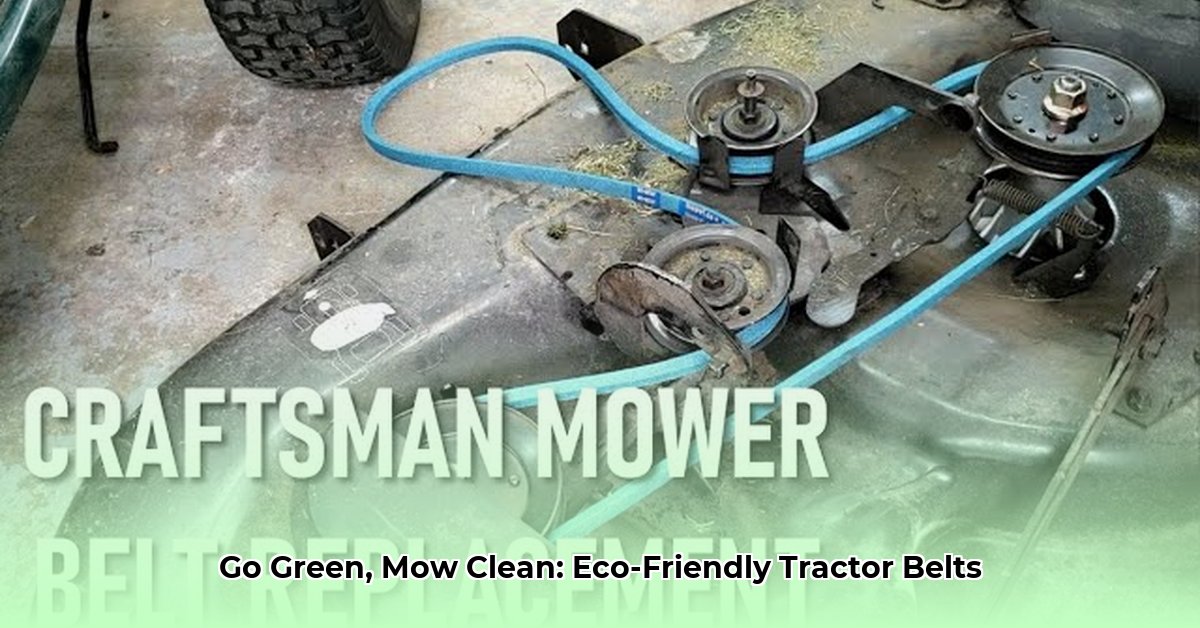
Choosing the right belts for your Craftsman lawn tractor is crucial for both its performance and environmental impact. This guide offers actionable steps to select, maintain, and dispose of belts sustainably, minimizing your environmental footprint while keeping your tractor running smoothly. For more information on mower blades, check out this helpful resource.
Understanding Craftsman Lawn Tractor Belts: Types and Their Impact
Craftsman lawn tractor belts are the unsung heroes of your mowing operation, transferring power from the engine to the cutting deck. However, not all belts are created equal, impacting both your tractor's performance and the environment.
Types of Craftsman Belts and Their Environmental Footprints
Several belt types exist, each with unique characteristics and environmental considerations:
Standard Rubber Belts: These are the most common and affordable option. However, their shorter lifespan leads to frequent replacements, generating significant waste. The environmental impact is considerable due to continuous manufacturing and disposal needs.
Kevlar-Reinforced Belts: Offering superior durability and longevity, these belts require fewer replacements, reducing waste. While the initial cost is higher, the long-term savings and reduced environmental impact often outweigh the upfront expense.
Belts with Recycled Rubber Content: Increasingly popular, these belts utilize recycled rubber, reducing reliance on virgin materials. Look for clear labeling specifying the percentage of recycled content. The environmental impact is significantly lower compared to standard rubber belts.
Table 1: Comparing Belt Types
| Belt Type | Durability | Cost | Environmental Impact |
|---|---|---|---|
| Standard Rubber | Low | Low | High |
| Kevlar Reinforced | High | High | Low |
| Recycled Rubber | Moderate | Moderate | Moderate to Low |
Did you know that replacing a standard rubber belt every year contributes significantly more waste than using a longer-lasting, sustainable alternative?
Choosing Sustainable Craftsman Lawn Tractor Belts: A Step-by-Step Guide
Selecting a sustainable belt involves careful consideration of several factors:
Prioritize Durability: A longer-lasting belt minimizes replacements, directly reducing waste and your environmental footprint. Check online reviews and manufacturer specifications for lifespan estimates.
Seek Recycled Content: Opt for belts containing recycled rubber whenever possible. The higher the percentage of recycled content, the lower the environmental impact.
Research Manufacturers: Investigate manufacturers committed to sustainable practices. Do they offer recycling programs for old belts? This shows a broader commitment to environmental responsibility.
Consider the Long-Term Cost: While the initial cost of a durable belt might be higher, the long-term savings and reduced environmental impact usually outweigh the extra expense.
Remember: A sustainable choice today contributes to a healthier planet tomorrow. This translates to reduced waste in landfills and a smaller carbon footprint from manufacturing.
Extending Belt Lifespan: Maintenance and Best Practices
Proper maintenance significantly extends belt lifespan, minimizing replacements. Follow these steps:
Regular Inspections: Inspect your belt regularly for cracks, fraying, or excessive wear. Replace damaged belts promptly to prevent further damage.
Correct Installation: Carefully follow the manufacturer's instructions for proper installation. Misalignment is a leading cause of premature belt failure.
Keep it Clean: Regularly clean the belt and surrounding area from debris to prevent friction and damage.
Proper Storage: Store spare belts in a cool, dry place to prevent degradation and maintain their quality.
These simple steps can significantly prolong your belt's life, saving you money and reducing environmental impact. A well-maintained belt can easily last twice as long as a neglected one.
Sustainable Disposal of Worn Craftsman Belts
When your belt reaches the end of its life, responsible disposal is crucial:
Check for Recycling Programs: Contact the manufacturer or retailer to inquire about belt recycling programs. Some companies are establishing initiatives to reclaim and recycle used belts.
Local Waste Management: If recycling isn't available, follow local guidelines for proper disposal. Never litter or discard belts improperly.
Did you know that rubber from recycled belts can be repurposed in other applications, further reducing waste?
Conclusion: Sustainable Mowing Practices
Choosing Craftsman lawn tractor belts involves more than just finding a replacement part. It is also about making conscious choices that contribute to sustainable practices. By prioritizing durable, recycled belts and following responsible maintenance and disposal methods, you directly reduce your environmental impact, promoting a healthier planet.
Resources:
- Link to Craftsman website
- Link to EPA guidelines on waste disposal
- Link to a reputable recycling organization